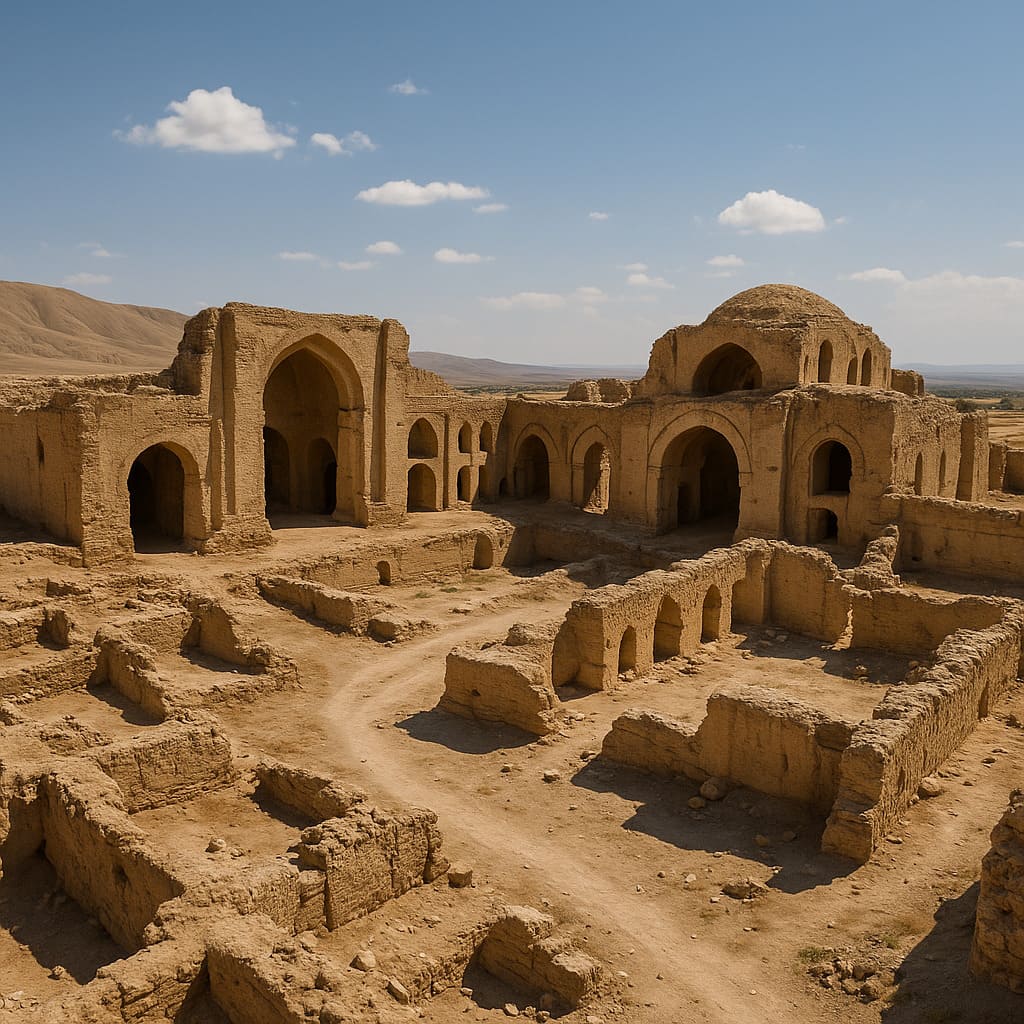Lashkari Bazar Ruins in Lashkargah, is one of many fascinating sites that both foreign visitors and local tourists can explore while they visit Afghanistan and exploring Helmand Province. Known for its wealth of historical and cultural significance, this site offers a glimpse of the past of this remarkable region, from the grandeur of ancient architecture to the events that shaped its history. Whether you are a history buff or just a curious traveller, Lashkari Bazar holds many secrets waiting to be unearthed.
Lashkari Bazar Ruins Most Important Events
- Establishment of Royal Palaces: Among the most considerable events in the ruins of Lashkari Bazar is the establishment of its royal palaces in the 11th and 12th centuries. These grand structures were a symbol of the Ghaznavid Dynasty’s power and wealth, which greatly impacted the region’s historical landscape.
- Several Intervention Periods: Throughout history, the ruins have seen several intervention periods, often caused by political instability and warfare. These interventions not only shaped the architectural aspect of the ruins but also affected the cultural inheritance in many ways.
- The Excavation Era: In the mid-20th century, a significant development occurred when French archaeologists began excavating the site. Many historical artefacts were uncovered, providing valuable insight into Afghanistan’s history and the site’s past glory.
History of Lashkari Bazar Ruins in Lashkargah
The history of Lashkari Bazar dates back to the Ghaznavid Dynasty, a Persianate Muslim Dynasty in the 11th and 12th centuries. During this period, the region was prospering under the rule of the Ghaznavid kings, who founded several palaces in the area. The major buildings were lavishly decorated, with intricate stucco designs, making it an architectural marvel of its time.
However, throughout the centuries, the site has seen a fair share of tumultuous times. It underwent several changes due to political transitions, wars, and natural disasters, all causing significant damage to its structures. Despite these interventions, the ruins have preserved quite a bit of their past splendour, providing archaeologists and historians crucial clues about the bygone days of grandeur.
In the 1940s, French archaeologists initiated a large-scale excavation, resulting in remarkable findings. They discovered numerous historical artefacts that shed light on the region’s cultural heritage. From pottery to inscriptions to architectural elements, these discoveries provided a broader understanding of Afghanistan’s history and culture.
Why It’s Important to Afghan History
Lashkari Bazar Ruins occupy a special place in Afghan history. The site stands as evidence of the rich cultural inheritance of the region, dating back to the Ghaznavid Dynasty. The grandeur of the erstwhile royal palaces is a testament to the architectural prowess of their era and has significantly helped historians understand the socio-political and economic conditions in the area.
Additionally, the excavations have contributed immensely to historical studies. The artefacts discovered reflect various aspects of the past, from lifestyle to trade relations, art, and craft. This information makes Lashkari Bazar a crucial historical site for the study of Afghanistan’s past society and culture.
Why to Visit Lashkari Bazar Ruins
One visit to Lashkari Bazar Ruins can transport you back in time. A sense of awe seizes you as you walk amidst the remnants of an ancient civilization, your steps echoing the stories concealed in each brick and stone. The combination of formidable history, architectural wonders, and the timeless aura, make the ruins no less than a living museum.
Furthermore, the scenic beauty of the surroundings adds to the charm of this historical site. Nestled amidst the vast landscapes of Helmand Province, the Lashkari Bazar Ruins are a treat to the eyes, making them a must-visit for any traveller.
The top highlights to look out for when visiting the Lashkari Bazar ruins are:
- The extensively adorned royal palaces
- The grandeur of Ghaznavid architecture
- The excavation museum housing the artefacts
- The captivating landscape surrounding the ruins
- The local Afghan culture and hospitality
The Lashkari Bazar Ruins is easily accessible via road, with plenty of local transport options available from Lashkargah. The best time to visit is during the cooler months, between October and April.
Cultural & Tourist Significance
In addition to their historical significance, the Lashkari Bazar Ruins play a crucial role in promoting tourism in the region. They attract historians, archaeologists, and travellers from around the globe, boosting the local economy and contributing to the country’s overall tourism revenue.
Culturally, the ruins are representative of Afghan architectural styles and construction techniques of the Ghaznavid period. The artefacts discovered here tell tales of centuries-old crafts, skills and livelihoods, making it a precious source for studying the past cultural life of Afghanistan.
Furthermore, the ruins serve as a reminder of the country’s rich cultural heritage and the resilient spirit of the Afghan people. Despite centuries of war and turmoil, the beauty of these ruins remains intact, symbolizing the unyielding spirit of the nation and its people.
Interesting Facts
The Lashkari Bazar Ruins have various intriguing aspects that are lesser-known. For instance, the ruins served as a military barracks during the early centuries. This military use lead to the name “Lashkari Bazar” which translates to “Army Bazaar.”
There’s a local legend surrounding the ruins about a hidden treasure. As per the myth, a vast treasure was buried under the ruins by ancient kings, which has yet to be discovered. While it remains unproven, this legend adds a layer of mystery and intrigue to the site.
Another interesting fact about the ruins is the discovery of several non-local artefacts during excavation. These items indicate trade relations between the Ghaznavid Dynasty and other civilizations, further highlighting the cultural and economic importance of the period.
In conclusion, the lure of Lashkari Bazar Ruins lies not only in its historical and cultural richness but also in the stories and legends it holds. This site is truly a gem in Afghan’s historical legacy and a must-visit for those fascinated with the heritage of ancient civilizations.
From the remnants of royal palaces to colourful legends, each aspect of Lashkari Bazar echoes a tale from the past, inviting us to journey back in time and relive the glory days of the Ghaznavid Dynasty while appreciating the resilience of Afghanistan’s cultural heritage.


